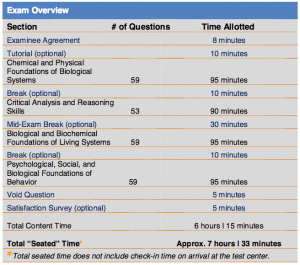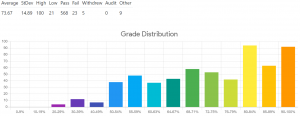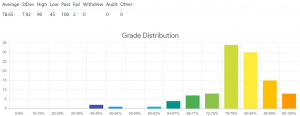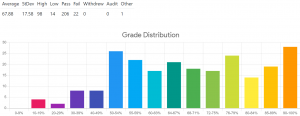Many science students want to pursue medicine in the future, however the process can be daunting. One of the biggest roadblocks is the infamous 7.5 hour MCAT. Here, I’ll explain what exactly is the MCAT, as well as my journey to scoring in the 99th percentile.
what is the MCAT?
The MCAT is a 7.5 hour exam that covers a broad range of topics. These include the Sciences and the Social Sciences. There subjects are grouped into four sections: Chemistry/Physics (59 questions), Critical Analysis and Reasoning (53 questions), Biology/Biochemistry (59 questions), and Psychology/Sociology (59 questions). All the questions are multiple choice, and there are broadly two question types.
The first type is concept questions, which solely test your content knowledge. Theoretically, if you did a perfect review of all the concepts covered by the MCAT, these should be “free” points. The second type is research-based questions. You are required to read a research passage adapted from the primary literature and answer questions about the passage. Some research-based questions can be answered by solely looking at the passage itself, but some are reliant on content knowledge.
The Critical Analysis and Reasoning section (CARS) is different from the other three. The good news is that it is all passage based questions that do not rely on any background knowledge. The bad news is that the passages are incredibly dense and cover an impossibly broad range of topics from history to art to music.
test-taking conditions
I took my exam at the Bentall Centre in Downtown Vancouver. You check-in upon arrival and they give you a locker and key to store your things. They take a picture of you and do a fingerprint scan (which they use to confirm your identity every-time you leave or enter the testing room). They also put your phone in a sealed bag, which you can store in your locker; however, the bag must not be torn open. They stagger the exam start times, so not everyone begins at the same time, thus you don’t have to worry about washroom lineups during the scheduled breaks.
When entering the testing area, they will ask you to pat yourself down. They will also provide you with ear plugs and noise-cancelling headphones. In terms of scrap paper, they give you many erasable note pages, which I found to be more than enough (you can ask for a clean one after every break as well).
In terms of environment, the temperature was comfortable (I just wore a T-shirt). Both the break area and testing area are monitored with video cameras; however, you are allowed to talk to other test-takers during your breaks (just not about the exams).
My study Guide: Content review
I began studying late June and aimed to take the exam on September 7, giving me roughly 2 months. For the first month, I would do content review. For content review, you want to spend more time on what you don’t know. Since I am majoring in Chemical Biology, my general/organic chemistry knowledge was more in-depth than what is needed for the MCAT. I had also taken some introductory physics courses so my main focus was on the physiology aspect of Biology, Biochemistry, and Psychology/Sociology.
I used the Princeton Review books, and I read 1-2 chapters a day (however, I read the entire chemistry books in one sitting). By focusing on a small amount of chapters, I could focus on memorizing all the details instead of unnecessarily cramming the information by reading an insane amount of chapters.
Along with reading, I would also do two other things during content review. Thrice a week I would write out all the biochemistry pathways and amino acids. There are around 6-7 pathways to remember and it is important to memorize these as they are “high yield” (likely to show up). I would also do 2-3 Jack Westin passages a day to practice my reading comprehension for CARS. I probably ended up studying 6-7 hours a day (although it should’ve been 4-5 hours, but I’m guilty of procrastinating).
my study Guide: practice problems
The AAMC prep bundle is your friend! Definitely buy this resource! This is really the only purchase you need to make in terms of paid practice material. Third party practice material (Kaplan exams, TPR exams, etc) are unnecessarily complex, and their practice exams score very harshly to scare you into buying one of their prep courses (which can cost upwards of 1000$). Some free resources I used were the 100 free questions from UWorld and the free Khan Academy passages.
For the first days I aimed to do 60 practice questions a day. I later began doing 120 questions a day, which is equivalent to half a MCAT, therefore ramping up my test-taking stamina. I would mix and match questions from different section banks (eg. 30 questions CARS, 30 questions Chemistry, 30 questions Biology, 30 questions Physics), so I wouldn’t be too bored from doing 120 questions of the same subject.
I took my first full-length exam in the middle of week 2 of practice problems and scored a 515. This gave me an indicator on which subjects I needed to work on (in my case CARS and Psychology/Sociology). Thus I dedicated 2 days to rereading my Psychology/Sociology books and grinded out more CARS passages on Khan Academy and Jack Westin, before going back to my regular schedule of 120 questions a day.
I scored a 518 on the next two full-lengths. However, my CARS scores were abysmal and were hovering around a 124-126 (44-67 percentile). By this time school had started, so I really had to be selective on what I was going to study. I had 3 days left. I decided that I was going to spend these next 3 days solely on CARS, and I redid most of the AAMC CARS questions.
My actual score was a 523. With my CARS section being in the 95th percentile (129)! Even though it was still my lowest section score, I was very proud of myself for improving so much. Every minute of the past two months suddenly seemed very worth it when I got my score back!
my test expenses
The MCAT isn’t cheap, but I think I spent less than your average applicant. I bought the Princeton Review set for 80 CDN (used). There are also ways to get review books for free if you’re very google-savvy ;). I spent around ~350 USD booking my exam, and ~300 USD (which I split with a friend) on the AAMC practice bundle (all including tax). Apart from these, I didn’t spend any extra money on third-party materials or any prep courses (the costs would be ridiculous). Remember, the more time you invest in studying, the more money you will save, as another retake would cost you ~350 USD more.
I hope you guys found this useful!







